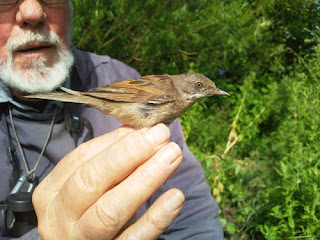Yes, Rich and I beat the dawn chorus and headed down the stables for a bash at mist netting some swallows, so that they could receive the bling they so badly needed. And indeed, we caught some swallows and duly ringed them. One female was crawling with lice. Not something one enjoys seeing at silly o'clock in the morning, but I am sure somewhat more unpleasant for the unfortunate hirundine.
We then joined up with more of the ringing group at Cardiff Bay. I obviously hadn't read the dress code, as I hadn't brought a hat. Rosie's won the vote for hat of the day.
It was a good bird day. We closed nets at the grand total of 66 birds, including lots of new warblers and thrushes. Plenty of fledglings about, including reed and sedge warblers, blackcaps and whitethroats. We even got a couple of reed buntings, which have been avoiding the nets of late.
 |
| A rather scruffy adult whitethroat |











 Yesterday evening was also the first opportunity in several weeks to check on the birds breeding in the stalls. Up in the roof, one nest contained young roughly eight days old, while the other contained at least three young who will be ready to take to the wing proper in a week or so! The first egg date will have to be revised!
Yesterday evening was also the first opportunity in several weeks to check on the birds breeding in the stalls. Up in the roof, one nest contained young roughly eight days old, while the other contained at least three young who will be ready to take to the wing proper in a week or so! The first egg date will have to be revised! 